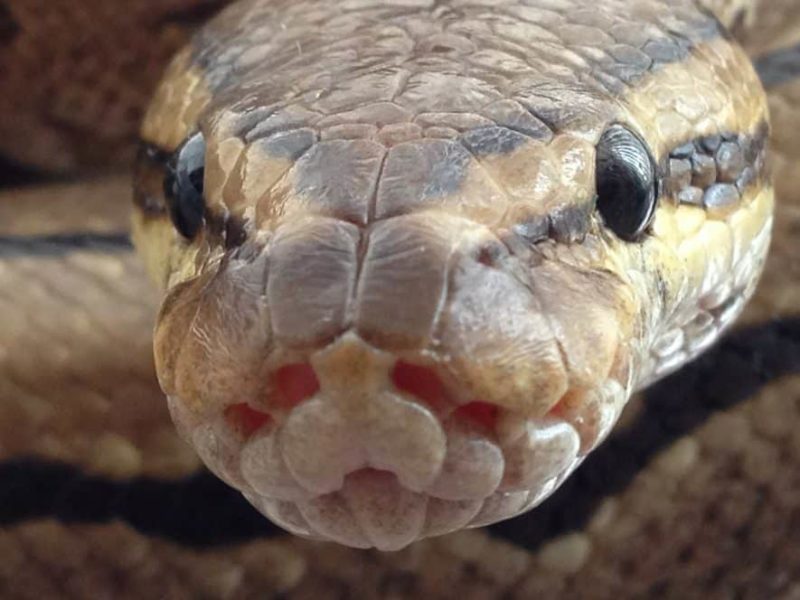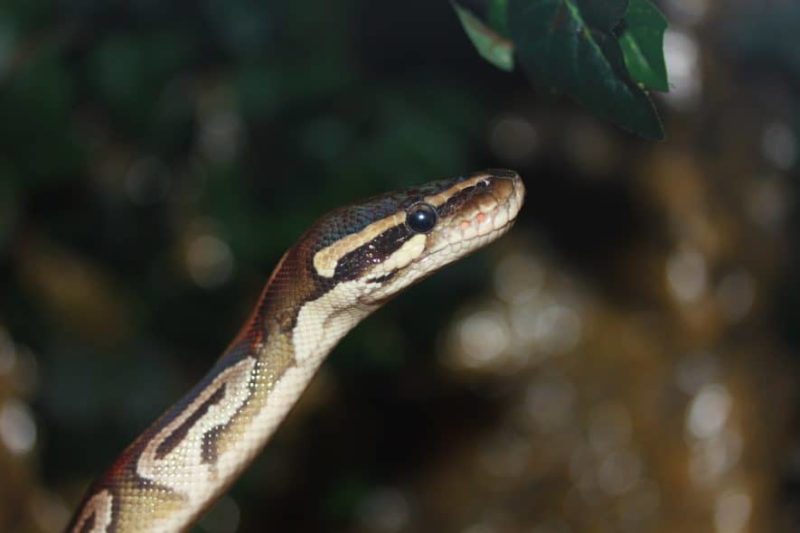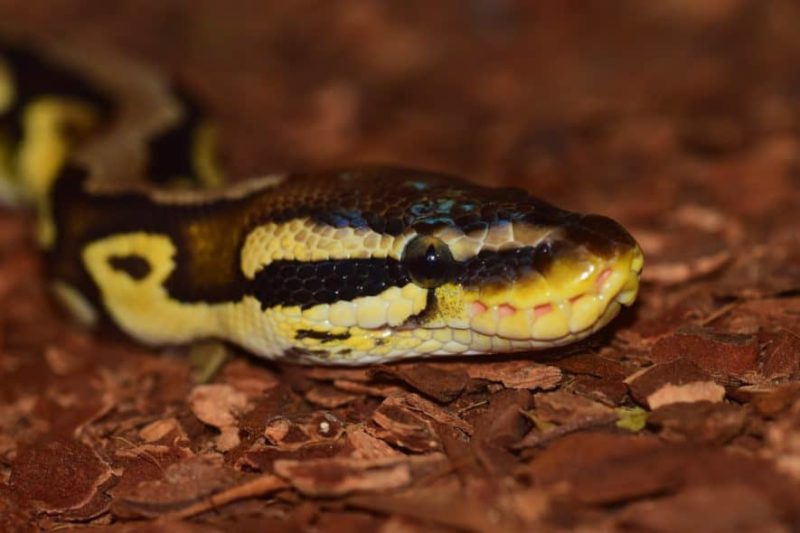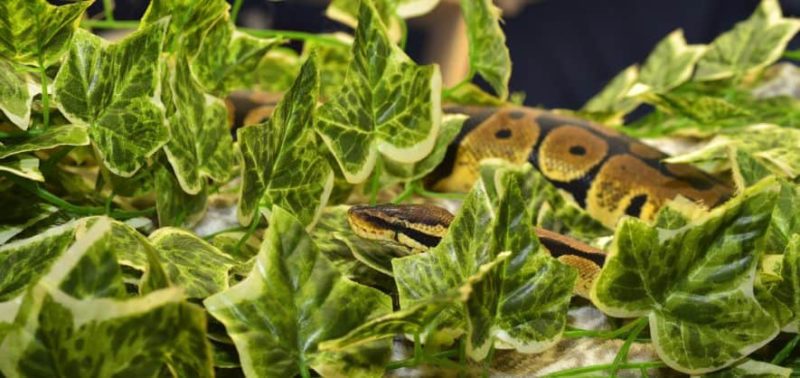When choosing a pet reptile you have to understand their health issues and typical behaviors. Some species can be challenging for beginners, so look for a pet that’s naturally hardy and easygoing – like the ball python (but only the captive-bred ones)
Early in my reptile-keeping journey, I worked with thousands of wild-caught ball pythons and almost all of them arrived with multiple health problems like tick infestations, respiratory infections, poor sheds, and infected wounds were very common in them.
But captive-bred ball pythons are a world apart. They are healthy, adaptable, and among the sweetest-natured snakes out there.
Honestly, what more could a first-time snake owner wish for?
Want to know more about the behaviors and illnesses of ball pythons? Keep reading!
Key Takeaways
- Healthy ball pythons typically lie in a flat coil, move slowly, often flick their tongues, and may lie in wait for food. When scared, they might hiss, flee, or curl into a protective ball.
- Ball pythons shed periodically, after every 4 to 6 weeks, or as rarely as once or twice per year
- Ball python bites are not dangerous and are very little painful.
- Handle your ball python in short, infrequent sessions to avoid stress.
- Respiratory infections, the inclusion of body disease, obesity, mites, and mouth rot are common health issues.
Quick Navigation
> Further Reading: The Complete Ball Python Care Sheet
Basic Ball Python Behavior and Body Language
You’ll notice your ball pythons performing a few common behaviors over time, including those explained below.
- Calm ball pythons move about slowly but purposefully.
- Ball pythons often flick their tongues while moving about to learn about their surroundings. This helps them gather information through scent particles that stick to their tongue and are analyzed by an organ in their mouth called Jacobson’s organ.
- Hungry ball pythons often lay motionlessly, with their head poised and ready to strike. They may also prowl slowly around the habitat seeking prey.
- When frightened, ball pythons may withdraw their head into an “S-coil,” hiss, flee or roll into a ball.
- Although it is somewhat rare, ball pythons can bite if they feel threatened or mistake your hand for prey.
Common Ball Python Behaviors: A Deeper Look
We’ll examine a few of the more noteworthy behaviors ball pythons exhibit below.
Shedding
Ball pythons, like all other snakes, shed their skin periodically. This can occur as often as once every four or six weeks for younger and healthy snakes, or as rarely as once or twice per year for adults, depending on the size, age, and health of the individual.
The shedding process starts with the snake’s belly turning a pinkish color and the overall scales appearing dull. A few days later, the eyes will take on a milky blue or opaque appearance. Following the blue eye phase, the snake’s colors will clear up again right before the shed occurs.
Proper sheds should come off in one long piece. But unfortunately, ball pythons who are sick, mite infested or dehydrated often shed in multiple pieces or fail to shed completely. This is called dysecdysis and can cause long-term health problems in some cases, so it is important to take steps to eliminate the problem.
Make sure your ball python’s enclosure has a proper humidity range of 50-60% at all times, with increased humidity (around 70-80%) during shed cycles. A hygrometer will be best to monitor these levels. And provide your ball python with a secure, humid hide, especially during its shedding cycle. Fill this hide with damp sphagnum moss to create a high-humidity safe space. Additionally, slightly damp substrate can help maintain humidity levels in the enclosure. Always provide a large enough water bowl for your snake to soak in if it chooses to.
Handling Stuck Shed:
If your ball python is having trouble shedding, there are safe and effective ways to help. Create a homemade humidity chamber using a plastic container with ventilation holes and a warm, damp towel placed inside. Place the container on a heating pad set to 85 degrees Fahrenheit (regulated by a thermostat). Once it gets warm, place the snake inside. And, cover the container with a cloth to reduce stress in your snake. Keep the snake in the chamber for no more than one hour, then return it to its enclosure. Repeat this process if the shed does not come off within 24 hours.
After using the humidity chamber, if you still see some stuck shed try gently aiding its removal using a damp cloth or cotton swabs. Always work in the direction of the scales. Do not force any scales off, especially near the eyes or the face.
Important Note: While soaking was once common advice but now it’s considered potentially stressful and even dangerous for ball pythons due to the risk of drowning snakeheads by many owners. Instead, use the humidity chamber method.
> Further reading: Ball Python Shedding: All You Need to Know
Biting
Biting is the behavior that often elicits the most attention from new keepers. This is understandable – nobody wants to be bitten by a snake.
However, it is important to note that ball python bites are rarely very painful, nor are they likely to cause much damage. Typically, they’ll cause a few minor breaks in the skin, which will ooze a trickle of blood.
Bites rarely require much more first aid than simple soap and water. However, if the bite displays any signs of infection (redness, swelling, etc.), contact your doctor. It is also important to feel the wound carefully to ensure no teeth were left in your skin.
> Further Reading: Does a Ball Python Bite Hurt (and Why Would Your Pet Bite)?
Handling Your Ball Pythons: Basics, Tips, and Tricks
Below, we’ll discuss the best way to handle your ball python, and then we’ll share a few tips and tricks that’ll likely make it easier and more enjoyable to do so.
Basic Ball Python Handling Procedure
Although you’ll certainly need to adjust to different circumstances and individuals, the best way to handle your ball python is as follows:
- Open the habitat and touch your snake gently on the back. This will help you avoid startling him if he’s sleeping (it is essentially impossible to tell if your snake is just sitting still or sleeping, as they lack eyelids).
- Place your fingers under his body gently and lift him off the cage floor quickly and decisively. Don’t stare at him for 10 minutes trying to gather your nerve; that’ll only make him nervous. Just pick him up.
- Once lifted, let your snake crawl freely around your hands and arms. Be sure to support him but avoid gripping his body tightly – that tends to make snakes feel threatened.
- After about 5 to 10 minutes (or you are done examining him, if that was your reason for picking him up in the first place), gently return him to his habitat and close the enclosure.
- Wash your hands with soap and warm water.
Tips and Tricks
Try to follow the procedure outlined above, but from time to time, you may find the following tips helpful:
- Learn to recognize your snake’s body language. Typically, ball pythons will communicate discomfort or fear long before they resort to biting. They’ll often do this by tensing their muscles, becoming more rigid, hissing or acting “jumpy.” If you note these signs, return your pet to his enclosure and leave him alone.
- If you must pick up a defensive ball python, use the “paper towel trick.” By simply covering your snake with a paper towel (or small hand towel, if your snake is large), you’ll find that most snakes calm down significantly. You can then pick up the entire package – snake and towel – and move him as necessary.
- A snake hook (or an improvised version thereof) can make some snakes feel more comfortable. After lifting the snake with the hook, you may be able to transfer him to your hand without a problem. Otherwise, you can simply use the hook to move him as necessary.
- Don’t handle your snake too often or for too long. Excessive handling will usually stress your snake out, so keep handling sessions brief. Also, don’t bring your snake to public places, as this is stressful to the snake and often upsetting to those who are not comfortable with snakes. This type of behavior only hurts the hobby.
- Because they’re nocturnal, ball pythons are generally easier to handle during the day. You’ll often find that your ball python will be more alert at night, and they’ll generally be less tolerant of handling during such times.
Caution: Don’t Handle Your Ball Python After Eating
Note that you should never handle your ball python who’s recently eaten. Doing so may cause him to regurgitate his last meal. This not only creates a thoroughly disgusting mess, but it is also stressful for the snake. It’s also a waste of money, as that rodent will now be useless.
As a general rule, the minimum you should wait after feeding before handling is 24 hours. However, it’s far safer to wait 48-72 hours (if your snake ate larger meals) to ensure complete digestion. This assumes that any bulge created by the meal has shrunk. If you can still detect a food bulge, do not handle your snake.
> Further Reading: The Ball Python Diet
Illness and Disease: Signs of a Sick Ball Python
Some of the most common health problems that afflict ball pythons are explained below. These are certainly not all of the possible diseases and conditions that may threaten your pet, but they deserve the most attention.
Respiratory Infections
Any snake can suffer from a respiratory infection, but snakes that hail from tropical areas – including ball pythons – are often especially susceptible to them. Because snakes cannot cough, they have great difficulty expelling the fluid which can accumulate in their respiratory tract. This means that a simple “chest cold” can quickly prove fatal in snakes.
A few of the most common symptoms of respiratory infections in ball pythons include:
- Blowing bubbles from the nostrils or mouth
- Wheezing, clicking, or gurgling sounds when breathing
- Drooling
- Labored breathing or open-mouthed breathing
- Food refusal
- Staying near the heat source more often than usual
- Lethargy or decreased activity levels
If you notice your ball python exhibiting any of these symptoms, temporarily raise the temperatures within your ball python’s enclosure slightly. Aim for the high end of their recommended temperature range to support their immune function.
While ball pythons occasionally recover from extremely mild respiratory infections without veterinary treatment, most will require medications to help combat the infection.
Inclusion Body Disease
Inclusion Body Disease (IBD) is a severe and deadly viral infection. It affects snakes within the boid family, which also includes ball pythons. Infected snakes show symptoms that include neurological problems (like stargazing, tremors, and disorientation), respiratory difficulties, and digestive issues such as regurgitation and weight loss. Sadly, there is no cure or treatment for IBD. As it’s highly contagious and causes a lot of suffering to the animal, euthanasia is only considered the most humane option to prevent the spread of the virus and end the snake’s suffering.
Prevention is always the key to IBD, and it’s important to only buy snakes from breeders who test for the disease, and strictly quarantine any new snakes for a minimum of 3-6 months. Cleaning the equipment and affected areas thoroughly is also essential – especially if your snakes have been exposed to the virus. If you think your ball python might have IBD, keep it away from other snakes and get help from a vet right away.
> Further Reading: How to Tell if My Ball Python Is Dying?
Obesity
Obesity can cause health problems for ball pythons, so it is important to keep your snake at the proper body weight. While experienced keepers are often able to accurately assess body condition, it is often difficult for novices to do so. Accordingly, beginners should visit their vet regularly (perhaps once per year) to ensure that their snake is in good health.
Some of the most notable locations in which ball pythons store fat include the rear portion of the head and the sides of the tail base. Additionally, the spine and ribs can provide clues to the snake’s body condition. You should be able to feel your snake’s ribs, but they should not be visible in most cases. A healthy ball python has a smoothly rounded, triangular body shape when viewed in cross-section.
Obesity takes a long time to treat in snakes – they don’t need very many calories in the first place. Accordingly, it is important to avoid the problem entirely by carefully managing your snake’s diet and feeding frequency.
> Further Reading: The Ball Python Diet
Eye Infections
A lot of new owners worry that their new ball python has an eye infection, but eye infections aren’t terribly common in snakes. I can only remember caring for one snake out of thousands that had a legitimate eye infection – and that was a water snake, not a ball python.
However, ball pythons do frequently experience two other eye-related problems:
- The eyes of dehydrated ball pythons will often dimple.
- Shedding difficulties can cause a snake to retain the scale covering its eye.
Unfortunately, it can be very difficult for beginners to distinguish between these two problems. So, the best thing to do is simply visit the veterinarian if you notice anything unusual about your ball python’s eye. Neither of these issues is terribly difficult for your vet to treat – he or she can likely remove a retained scale or help you rehydrate your pet.
Mites
The snake mite (specifically Ophionyssus natricis) is a tiny arthropod that feeds on the blood of snakes. And unfortunately, they are both extremely common and extremely difficult to eradicate – particularly for snake-keeping novices.
Individually, mites don’t represent much of a problem, although they’re probably irritating to the snake. But, when their numbers climb into the dozens, hundreds or thousands, they can cause serious physical stress. Death from mites is rare, but it is possible.
Mites essentially look like a moving speck of black pepper. They’re easy to spot against a white enclosure wall, but they’re very difficult to see on the dark portions of a snake’s body.
The easiest place to see them on your snake will be his ventral side, especially the portion under the chin (check in the crease running down the center of your snake’s lower jaw). You may also find them clustered around the eyes, mouth, or vent area.
Eradicating mites is complicated because the mature females are constantly leaving your snake, moving into the environment and depositing eggs. So, you’ll often have to utilize special medications that will kill the next generation of mites, or you’ll need to go to great lengths to eliminate the mites on your snake and those living in the environment.
In either case, beginners are wise to immediately seek veterinary assistance when confronted with mites.
> Further Reading: Mites in Ball Pythons
Mouth Rot
Mouth rot, also known as infectious stomatitis, is a bit of a catch-all term for various infections that manifest in the mouth of a snake. It is pretty disgusting – it can cause your snake’s mouth to bleed, ooze cheesy material, loose teeth or worse. Common culprits include Aeromonas, Pseudomonas, and various other opportunistic bacteria. But if caught quickly, you’ll usually be able to stop the problem.
Mouth rot can be caused by a variety of different things like small injuries in the mouth from prey, rough substrate, decor, weekened immune system and poor husbandry, so you’ll need to work with your vet to treat the animal. Just be sure that you do so quickly, as this problem can progress drastically in a short period of time.
Take Care!
Ball pythons are usually healthy and easy-going animals. You just have to start with a healthy, captive-bred individual and then provide the proper habitat, diet, and care. Just be observant and look out for the symptoms of illness mentioned above. This way, you’ll be able to act quickly and give your snake the best chance of recovery.










204 Comments
Hey! So I recently got a snake from my boyfriends sister, it was about 3 days ago or 4.. i think. I fed him not too long algo and i was told to wait a week before feeding him again. But the thing is, he’s always hiding and not coming out very often, and it’s starting to worry me, about a couple minutes ago I tried to get him out and holding him on my hands to see if everything’s okay but he seems skittish, almost like he’s scared. I was trying to touch his head but he keep dodging me like he doesn’t like to be touched there. I can’t tell whether he trying to attack me when I try to touch him, pick him up or holding or he’s just scared, I don’t want anything wrong physically happening to him, is there any way you can answer me and tell me what might be wrong with him?
Hey, Kai.
It’s true that you should wait several days to handle your snake after feeding him (although a week is probably unnecessary – two or three days would be fine). As for his hiding behavior, that’s just what many snakes do! They spend their lives hiding from predators, so that sounds normal.
As for touching his head, most snakes will not like that. Instead, just hold him in your hands and let him crawl around like he wants to.
Best of luck!
My ball python is still very young a couple of months and he just moves very weird! Like he doesn’t have much control of his muscles… he is falling off of stuff because he can’t grip that well. We call him noodle because well he moves like one and is not very good at periscoping and tends to fall when doing so. Any thoughts?
Hey, Ashley.
That does not sound good. Is your ball python a spider morph by any chance? That mutation is associated with some neurological problems that can cause poor coordination.
At any rate, we’d recommend getting Noodle to the vet ASAP to see what’s going on.
Best of luck!
Hi again! You were so helpful with my last question a few months ago, I thought I would reach out again.
I recently took my BP to the vet for a check up. He’s 1 year old this month.
I brought him to the vet because he’s been absolutely restless in his tank every single night since the temperature change lately- understandable behavior. All of his temperatures are good except his ambient was a bit low last week (our apartment was too cool since the weather is changing, and they didn’t turn the heat on yet).
The vet said he looked fine but recommended a space heater, which I got.
Now I have the space heater, my temperatures are completely right, And I cleaned out his tank and every item in it and switched out his substrate.
But my BP is still restless at night. He climbs up and down his walls all night- (I built a climbing wall for him a few months ago so I’m sure he’s enjoying the adventure, but it’s non stop)
Ps during the day he sleeps well, occasionally switching from warm hide to ambient hide, but not climbing at all.
Tonight, I fed him a rat and he ate it within minutes. He digested it for about 1 hour, and now he’s back to roaming around. I’m shocked he’s not trying to digest it longer, he usually relaxes after a meal. I’m afraid he’s going to accidentally cause himself to regurgitate.
I have absolutely no clue why he’s so restless. Do you have any thoughts, or suggestions that I’m not thinking about? The vet had nothing.
Thank you so much..
Hey there, “Restless!”
😊
As long as your temperatures are OK and he’s eating normally, I wouldn’t worry! Some ball pythons are more active than others, and most will explore at night – including climbing a bit.
Just make sure to keep his temps correct and you should be fine! Keep up the good work!
Hey, Ben
I have got my baby python (2 months old) for 4 weeks, he hasn’t eaten anything for these days, and his last shed is about 3 weeks ago. I haven’t touched him for 2 weeks and always keep the tank dark. He seems to be healthy, without any tick infestations and respiratory infections. I guess he must be too anxious to eat, but the time is so long so I’m afraid that he would stave himself to die. Until today, I can’t see its ribs.
Only at night, he would be out of the hide and wonder in the tank. I tried to feed him several times when he seems active. But when I perform the ‘zombie dance’ or even cut the mouse, he shows no concentration about the mouse, sometimes like to be scared.
Today and yesterday I noticed that he put his head out of the hide, and fell in sleep. He had never done that before. When I wake him up (I’m so afraid that he is dead), he shows a flexible and quick response. I don’t know if it is a sign of relaxation, weakness, or appetite. Do you have any suggestions?
Hey there, Wenjia.
It’s really hard to tell what’s going on with your snake without seeing him, but if he hasn’t eaten in a month, I’d recommend having your vet check him out.
You may also want to watch some YouTube videos of other keepers feeding their ball python to learn some of the techniques (which can be hard to put into words).
Best of luck!
Hi Ben, I’m hoping you or anyone reading this can help. Our Ball Python has started exhibiting a strange behaviour that I can’t find any information on. We remove him from his viv to manage some basic husbandry, 10 minutes at most because he’s in a bioactive set up, so its just to move things about and remove anything the clean up crew missed. When we replace him sometimes he convulses, as if he’s trying to shake something off. It’s violent though and moves the cork bark and hides if he’s close enough to them. Cold sides 24°C hot 33° under the ceramic heater. Humidity is 65 hot end, 80 cold. Have you come across this behaviour before?
Hey there, Chris.
That does sound troubling, but I’m not sure what it could be. Your temps and humidity levels sound fine.
Is he a spider morph? They typically exhibit neurological problems that may be part of what you’re seeing. At any rate, I’d recommend having your vet check him out to be sure. It may also be a good idea to simply things for a while, and keep him in a “sterile” (non-bioactive) habitat to see if the problem disappears.
Best of luck – keep us updated!
Hey, I got a Spidernet Morph Juvenile Ball Python a couple of days ago, and while she seems comfortable, or at least I think she is, she keeps doing this weird massaging thing at random intervals whenever my mother or I hold her, and occasionally she’ll rub her face against my mother like a cat, and will only stop when she’s being pet. Is this normal?
Hey, Daylin.
I don’t completely understand what you’re describing, but it sounds like it could just be typical spider ball python “wobble.” That mutation frequently exhibits bizarre movements, but it usually doesn’t cause huge problems.
If you’re worried about it, I’d recommend contacting the breeder ASAP.
Best of luck!
My Spyder Ball Python (about 1y/o) will often, for lack of a better term, Randomly start flexing when he is either on my wrist or forearm, never anywhere else, and he’s wrapped around it. Is this a bad thing? Am I doing something wrong? I am a first time snake owner and I’ve had my snake for almost a year as well. To be more descriptive it’s much like he’s doin the wave but with his whole body and by himself. Thank you for any help/advice you can give.
Hey there, Aephus.
It’s hard to tell from afar, but it sounds like he’s just exhibiting the typical issues that are common in spider ball pythons. If he is acting fine in every other way, I wouldn’t worry about it.
But, as always, if you’re concerned, reach out to your vet.
Best of luck!
I just bought my ball python about two weeks ago , and for some reason I think he might be a little frighten of me I’m not sure because he hiss or anything but when I come around he just freeze in one position he won’t move & that makes me nervous to pick him up because I’m not sure if I go to reach for him he might strike at me .
Hey, Tia.
It sounds like you’re just going through the same thing we all do when we first start keeping snakes: Learning to read your pet’s body language and behavior.
To the extent possible, try not to be nervous. That’ll help you feel better, and that means you’ll handle the snake in a more relaxed manner, and that will likely help him feel more relaxed too.
Best of luck!
Hi I have a 14yr old ball python named Creeper that was soaking in a tub on my porch earlier to assist him with shedding (for probably 20mins in a water level that was lower than the biggest part of his stomach) & when I walked back out front he was swimming frantically. Upon picking him up he is acting as if he is drunk (bobbing his head around- no body coordination) and he is also acting very lethargic. Additionally he has water bubbles coming out of his nostrils & Now he is holding his mouth wide open w/saliva dripping. There are No reptile vets in my area & I am really scared I’m gonna lose him if I don’t get him help. Can you tell me what to do to help this? Or what it will cost to bring him to you for an emergency visit?? Thanks in advance, hope you respond back soon. Shawna
The verbiage above was sent about 2 hours after soaking incident. And now I’ve checked on my snake periodically throughout the day and he was being non receptive to me spraying him/his cage with water to raise moisture level so I decided to get him out.
He now acts very skiddish/sensitive to any physical touching of his body, crawls much faster than ever before to get away from me & while he was on the ground in the yard I noticed him having muscle/body spasms (portions of his tale area were randomly twitching & rolling). He also had a couple water bubbles come out of his nostrils and overall is acting very uncoordinated like he can’t keep his balance. What should I do??
Hey, Shawna.
I’m so sorry I didn’t respond sooner, but I’m not sure I could have helped much.
It sounds to me like one of two things happened:
1) The water was too hot
2) Something in the water was toxic or noxious
In either case, you’ll really just need veterinary help. But, by this time, I’m sure he’s recovered if he was going to.
I know it can be hard to find a reptile vet in some areas of the country, but in those cases, you may want to try to track down a reptile-oriented vet who will at least provide phone consultations.
Again, I’m so sorry about your pet, and I hope he recovered.
Hey I have two ball pythons that rarely go in there water I’m new at this and I want them to be okay and not Dehydrated how do I help them drink or bathe. Like how do I know if they are dehydrated or just fine?
Hey there, Morgynne.
For the most part, all you’ll have to do is provide a dish full of clean water at all times. Your ball pythons probably won’t soak in their water dish very much, and they won’t drink as often as a dog or cat – they’ll likely just drink all of the water they need in the middle of the night a couple of times a week.
Just watch for signs of dehydration, such as wrinkled skin, poor sheds, and “indented” eye scales.
Best of luck!
Why is my baby ball python head tilting upside down and side to side? We just got him yesterday. He is also laying upside down and biting himself.
Hey, Margaret.
That does not sound like healthy behavior, but it’s difficult for me to pin down what the issue is. It could be a neurological problem (does your snake have the spider gene?), or it could be something else.
Just head over to the vet and start trying to narrow down potential problems.
Best of luck!
Hey so my ball python was fine he was happy only had him for around 3 week and now he is starting to get jumpy and preferring to be in his cold hide he used to be fine when I picked him up he also ain’t pooping only little white drops I find in his cage nothing else could you help me please
Hey, Rianna.
It sounds like his enclosure may be too warm. Double-check your temperatures and make any changes necessary. The “white drops” are urates – essentially the snake equivalent of urine. They’re not a problem at all.
But, if your snake is not pooping (and he is eating), then he may have a medical issue. I’d recommend heading over to the vet just to be on the safe side.
Best of luck!
I just got my ball python yesterday she’s green and black and is about a foot and a half long but she’s always very active during the day pushing at the top of her cage and is always sliding across the side glass what would this mean. She isn’t Aggressive Aggressiveat all she’ll get defensive but even when she does you can pick her up and she never hisses or bites. Is this normal behavior.
Hey, Matthew.
It’s tough to know for sure what’s going on from afar, but snakes will often explore the screened lid and lean against the glass. Just double-check your temperatures: Sometimes, snakes will exhibit this kind of “pacing” or “escape” behavior when they’re too hot.
But if your temps are fine, and he’s not exhibiting any symptoms, I wouldn’t worry.
Best of luck!
New keeper here: I have a 1 year old female who quit eating June 15 (it’s now July 10). I got her when she was 2-4 months old (October 2019) and she has always been a good eater. I weigh her weekly, before she eats to keep track.
I know it’s common for them to go on a hunger strike, but she went from 1023g (June 15) to 969g (yesterday). I called the vet and she said my snake was healthy, no signs of mites, RTI, but the vet simply doesn’t know why she’s stopped. The vet said as long as she doesn’t lose “a lot of weight” she’ll be fine.
I asked her what she considers “a lot of weight,” and she said “10%”.
My question: is there a time frame for this? What I mean obviously if she loses 10% overnight (without pooping), I should be concerned; but
57g in 3 weeks seems a bit excessive.
At what point should I take her back in?
[FYI: Her last shed was late May.
Last poop was June 28.
Doesn’t drink from her water dish (prefers her humid warm hide) and was instructed to soak her in lukewarm water 2-3 times/week for hydration- but the vet didn’t see signs of dehydration.
Temps were 80°/72° until yesterday (now 90°/80°).
Humidity between 65%-70%.
More clutter was added and she’s been very active for the last 2 weeks. I’m thinking she’s stressed and I’ve been handling her less lately.
She’s been in a 40g glass tank since March.
Last night she moved the back styrofoam piece and just stayed there.]
At what point should I take her back in?
I’m sorry about the novel, but wanted to make sure you have the whole picture.
Hey, Tara.
Sorry for our delayed response, but I’d like to give you a standing ovation for the effort you’re putting into your pet’s well-being. I wish more keepers were like you.
You’re measuring your temperatures. You’re weighing your animal regularly. It sounds like her habitat is set up well, and you’re working with your vet! Seriously, I hope others read your comment and learn from you.
I agree with your vet that as long as she’s healthy, you don’t need to panic. It would take a really, really, really long time for your snake to starve (multiple months), so don’t panic.
Leave her alone as much as you can, stay on top of your husbandry (as you have been doing), keep a good eye on her, and offer food once every three or four days until she starts eating again.
Snakes – and specifically ball pythons – will drive you crazy at times by fasting. But the vast majority of (healthy) fasting animals eventually start eating again.
I’d give it a month (again, assuming she doesn’t display any problems). If she’s still not eating, you could go back to the vet. But, I would try not to worry. It sounds like you’re doing fantastic, and I’ll bet she starts eating for you again soon.
Best of luck!
Question I just got a baby ball python and it will every now and then raise its head and open its mouth is that normal
Hey, Beverly.
Sorry for our late response, but that could indicate a respiratory infection or mouth problem. It’d be wise to have your vet check the little fella out.
Best of luck!
I just bought my 1st ball python it’s a baby I can’t tell male or female because it’s to small that’s what the pet store said, I go to get it out of its cage and it sticks his head straight up and just stares at me but when I pick it up it doesn’t bite but I’ve held it in my hand and it stands straight up and looks at me is it going to end up biting me or is it normal?
Hey, Heather.
Sometimes, snakes will extend their head upward to check things out or attempt to climb. I can’t make any guarantees, but it doesn’t sound like he or she is interested in biting you.
Best of luck!
Hi Ben,
I have a question about sudden behavioral change.
My male BP is 9 months old, and he’s always been the most chill and docile snake. I was able to handle him during the day and night without any issues.
However, over the month and a half he has become quite defensive at night. If walk into the room after 8 or 9 PM, he will just stare at me, coiled and even following me sometimes. He had one problem during this time, he was constipated. I have him a warm bath three days ago and he passed everything right away, and had a meal just last night. But tonight he is still behaving under defense when I’m in the room. I’m not even attempting to handle him (I always give 48 hours for digestion).
This is brand new behavior and I’m not sure what to do about it. Below are some facts about him/ his environment:
-He eats every 7-10 days, without any issues.
-He has had three perfect sheds, his last shed was two weeks ago (while he was constipated)
-He has two rock hides, along with some cage furniture/fake leaves
-his cool side sits at 76-78, warm side around 88-90, humidity around 60
-lives in a glass terrarium
-if he pokes his head out during the day time he’s extremely chill/not coiled in defense towards me.
I always fed him inside his own tank, but since he was constipated (due to ingesting substrate with a meal) I tried feeding him in a separate bin last night. It took a while for him to eat but he did. Not sure if I should practice this during every feed so that he starts distinguishing the bin for feeding time.. and not just any random night I’m walking by his tank
It’s really bumming me out that he’s not calm at all times anymore like he was for so long… did being constipated mess up his mood? I have no idea how to help him feel safer at night and not afraid of me.
For now I’ve covered some sides of his tank so he doesn’t have to see me walk by.
Again this behavior is only at night.
Thank you in advance for any advice, I will really appreciate it
Hey, Lo.
I don’t think the constipation changed his demeanor, but you may want to ensure he’s not becoming dehydrated (often the cause of constipation in snakes).
That said, your husbandry all sounds great.
It’s hard to tell from afar, but it sounds to me like he’s hunting, rather than being defensive. That’s normal for ball pythons, and it’s actually a good sign. It means he has a good appetite and isn’t likely to be feeling stressed. All that said, ball pythons are a bit more edgy/jumpy/nervous at night when they’re active. Most nocturnal snakes are the same way.
It’s probably best to avoid trying to handle him at night, but otherwise, I wouldn’t worry at all. It sounds like you’re doing a great job.
Keep up the good work!
Hi, I just got my ball python about three weeks ago and have been noticing a few small things here and there and am wondering if I should be worried or not. I’ve noticed he holds his head up slightly for about a minute or so at least once or twice a day. At first I didn’t think much of it but he yawned today and got a bit worried that he might have a respiratory infection. He has also started to spend most of his time on the warm side of his enclosure. I have checked if he has any mucus and I’ve listened to his breathing and everything seems to check out fine. I have fed him three times but he hasn’t defecated at all.
Hey there, Aesa.
It’d probably be a good idea to have your vet check your snake out. The yawning and sticking to the warm side of the enclosure may indicate a respiratory infection. Also, while snakes don’t necessarily defecate after every meal, a ball python won’t usually eat three times without eliminating.
Best of luck!
Hello! Wanted to reach out about my 4 month old BP. I’ve has him for over a month, have gone through the first shed, feedings etc fine. Pretty familiar with his behavior and when hes okay to be handled. one thing I haven’t been able to find any info on is this. When he comes out of the cage and in my hands/arms, he does this thing where he rubs his head and neck on me. Sometimes the skin on his neck/belly will sorta stick to my skin. I guess from rubbing n warmth. Is this bad or good behavior? There’s times hes even fallen asleep in that position. I dont see mites, he may be hungry again since it’s coming up soon(next feeding) Just cant find info on it. Strange because his neck skin will be folded kinda. (Picture a fat person’s extra skin) sorry best way I can describe it. Hope to hear from you soon. Thanks for taking the time to get back to all of us. think it’s cool to have someone care enough to help us newbies lol.
Hey, Rachel.
It’s hard to say for sure what your wacky ‘lil fella is up to, but I think I’m familiar with the behavior you’re describing. It’s somewhat like what snakes often do immediately before shedding their skin (it’s a way to cut the skin on their lips so they can start to crawl out of it).
But the thing is, they seem to do it at other times too.
Ultimately, as long as he’s healthy, doesn’t seem to be troubled by you handling him, and is free of mites, I wouldn’t worry about it. There’s just some things our snakes do that we’ll never understand-lol!
Best of luck!
Just bought my first BP, seems mostly healthy for a 3 month old, maybe a little under fed, but other wise healthy. He ate a mouse for me on the second day I had him, but ever since, he has stayed in his warm hide, and has not come out in 24 hours now. Is this normal? I did check to make sure he ate the mouse, and it was not just rotting in the cage. I have left him alone other wise. His tank temps are 94 and 75 on the cold end.
Hey, Cameron!
Sorry for the delayed response, but he sounds fine. Snakes will often hide and digest for a day (or two or three…) after eating a large meal.
It doesn’t sound like anything you need to worry about!
Thanks for reading!